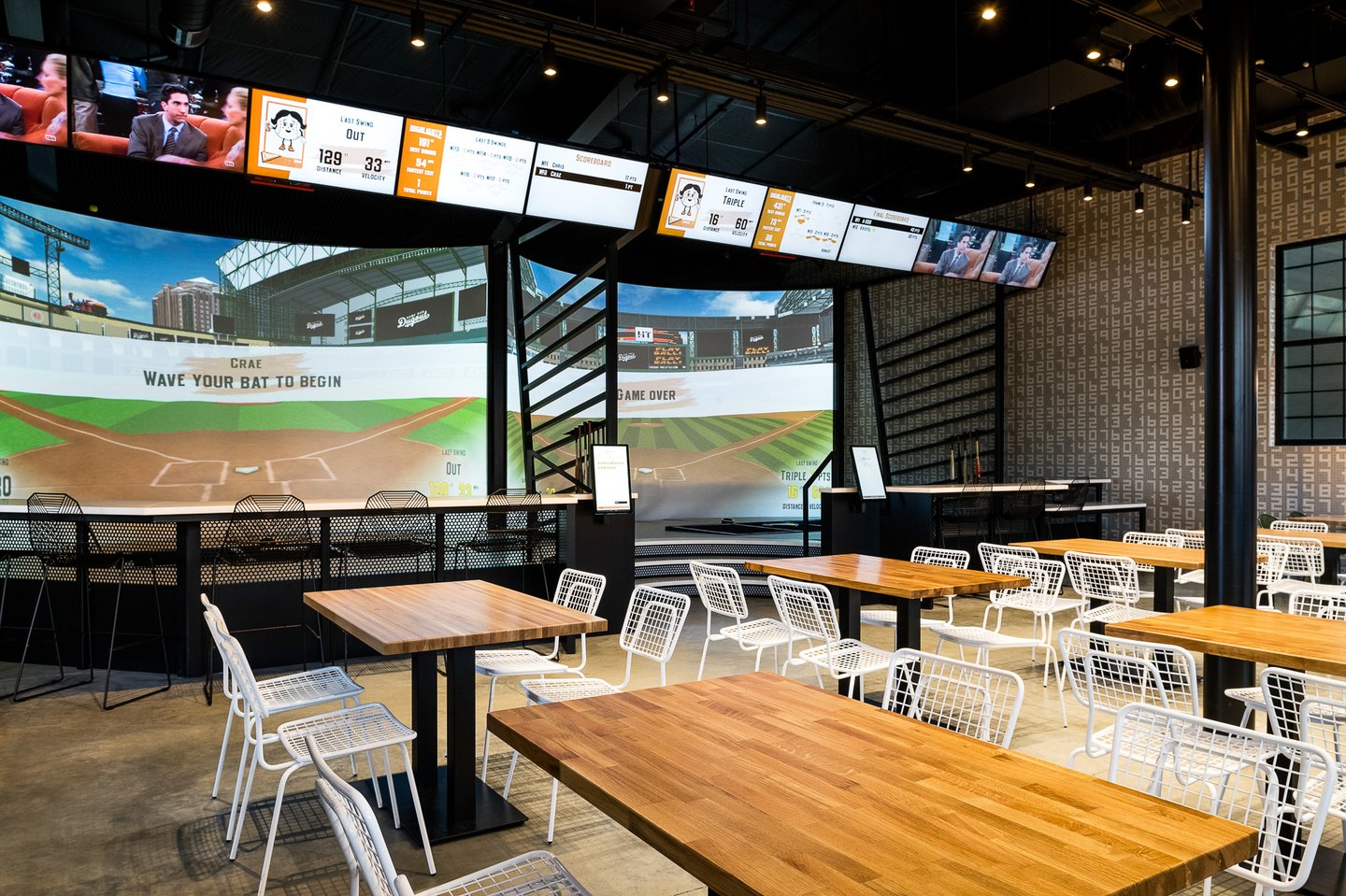Social experiences are the winning formula in sports entertainment venues
The best sports entertainment locations blend cool tech and elevated food-and-beverage offerings with the social experiences that all of us crave. By contrast, some concepts feel a bit out of balance: While their proprietary gaming technology is fun and impressive, their brick-and-mortar spaces sometimes function poorly or come across as uninspired.
Here are four tips for using architecture, engineering and interior design to raise your game in all dimensions of the sports entertainment experience.
Emphasize the social element
Based on optimistic predictions from a few years ago, we should all be living in the Metaverse by now. Instead, entertainment concepts offering in-person, tactile experiences — to be sure, often supplemented with augmented-reality (AR) or other simulation technologies that involve golf clubs, pickleball paddles, baseball bats and the like — are exploding in popularity.
Technology matters, in other words, but the priority should be on face-to-face human interaction in well-designed built environments, not pixellated immersion for its own sake.
Operators should never neglect the physical spaces that surround and celebrate their traditional and simulated game components. Ideally, these experiences will have a robust social dimension. Think of the difference between going into a room alone to play AR tennis, versus doing your best Novak Djokovic impression as your delighted kids watch, laugh and cheer you on.
What is the journey like before, during and after that AR experience? After finishing the game, will guests hear cheers and get high fives, or will they find themselves in an empty room staring at blank walls or walking down a lonely hallway to get back to their friends?
The physical spaces in which tech-interactions occur should feel enhanced, showcased and well-integrated into the overall social experience. You are on the right track if the visual surroundings suggest a natural next step with a social component — for example, sitting down with friends to grab a drink or split some flatbread and relive what just happened.
Maintain the energy
In Katy, Texas, Home Run Dugout offers a mix that includes 22 simulated batting bays, a restaurant, two bars, a large outdoor patio, a beer garden, live music and a baseball field. The batting bays are about 20 feet away from ball-catching canvases with venue images projected onto them (you can slug it out in classics like Fenway Park, Wrigley Field or even the “Field of Dreams” from the 1989 movie).
Home Run Dugout could have located these batting bays away from the bar and restaurant. Instead, the design team suggested placing the bays all around the main bar. The practical effect was to raise the energy level in this critical, revenue-driving part of the building. Even non-players who come out to eat and drink with friends can feel the energy and excitement created by sluggers in the bays. They might even be tempted to take a few swings themselves.
All of that said, gameplay should never impinge on the experience of people eating, drinking and socializing nearby. Architects can use distancing, sound-dampeners and partial visual barriers to keep things in balance. It is also important for each experience to have its own integrity. Home Run Dugout’s main bar area boasts elevated interior design and décor, as opposed to feeling like an afterthought festooned with standard baseball memorabilia.
Think about the operational side
Operational concerns also can affect the spaces that house and surround sports simulation and AR systems. Architects and engineers can help sports-entertainment concepts design and configure these spaces to maximize safety and efficiency, along with storage and ease-of-maintenance. For example, advanced simulation technologies often require intermediate distribution frame closets or rooms — basically, metal racks packed with cables connecting to end-user devices and other parts of the system — and/or separate spaces that house servers. Some systems are hardwired, others broadcast.
Regardless of the technical requirements, the goal should be to find secure locations that are easily accessible to IT and maintenance personnel, that allow the equipment to function at max capacity, and that never impede guests.
VR comes with some distinct concerns. If you have ever watched a blindfolded child whacking away at a piñata, you have a sense of the potential safety issues. Guests wearing headsets need to be able to walk around swinging a “light saber” or fighting a VR version of Muhammad Ali without hitting walls, falling or inadvertently KO’ing bystanders. Designers can help you choose the lighting levels, materials and space layouts that maximize the immersion while maintaining safety.
Serve all your patrons
Not so long ago, some entertainment concepts would zero-in on narrow demographic profiles — “Our sweet spot is young singles, ages 21 to 33, with significant disposable income.” Today, their aim is to create satisfying experiences for a wider array of patrons.
Early in the planning process, designers can work with sports-entertainment companies to focus on the needs of specific patron profiles. Yes, that could include hardcore sports fans and gamers, but grandpa and grandma might be part of the mix as well. Where will the grandparents sit? What will they do? Will it be easy for them to find a family restroom and keep an eye on the grandkids?
Generally speaking, older adults are more likely to patronize the business earlier in the day or evening. By adjusting volume levels, lighting and music based on the time of day, you can cater to the needs of different demographic groups.
At the same time, it is not necessary to turn the concept into a “family fun center.” Staying true to your core identity could mean saying no to things like playgrounds, cartoon murals or other amenities that run counter to your aesthetic and vision. Local baseball enthusiasts love the gaming area at Home Run Dugout, but in thinking about non-gamers, too, the design team created a semi-conditioned beer garden that has become a neighborhood hotspot. Not everyone who comes to your space does so to power-serve pickleballs or nail penalty kicks in a simulated World Cup final.
Play the long game by making sure your patrons have a satisfying, well-rounded experience that will keep them coming back for years to come.
Matt Tillman is a hospitality + entertainment team lead at HFA Architecture + Engineering, where he has played a central role in concept design for well-known companies in the sports entertainment, fast-casual dining, and arcade/sports bar industries.






